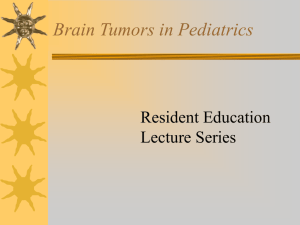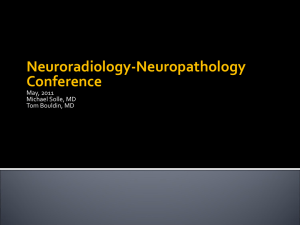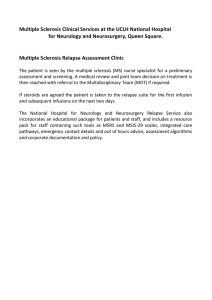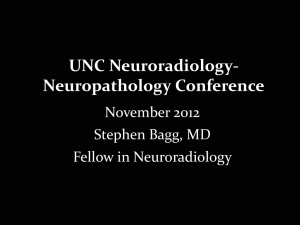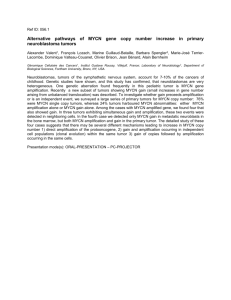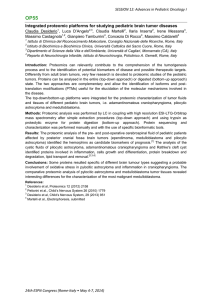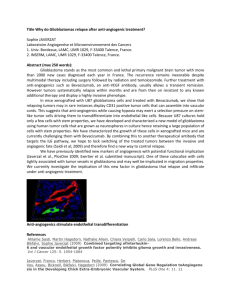Article
advertisement
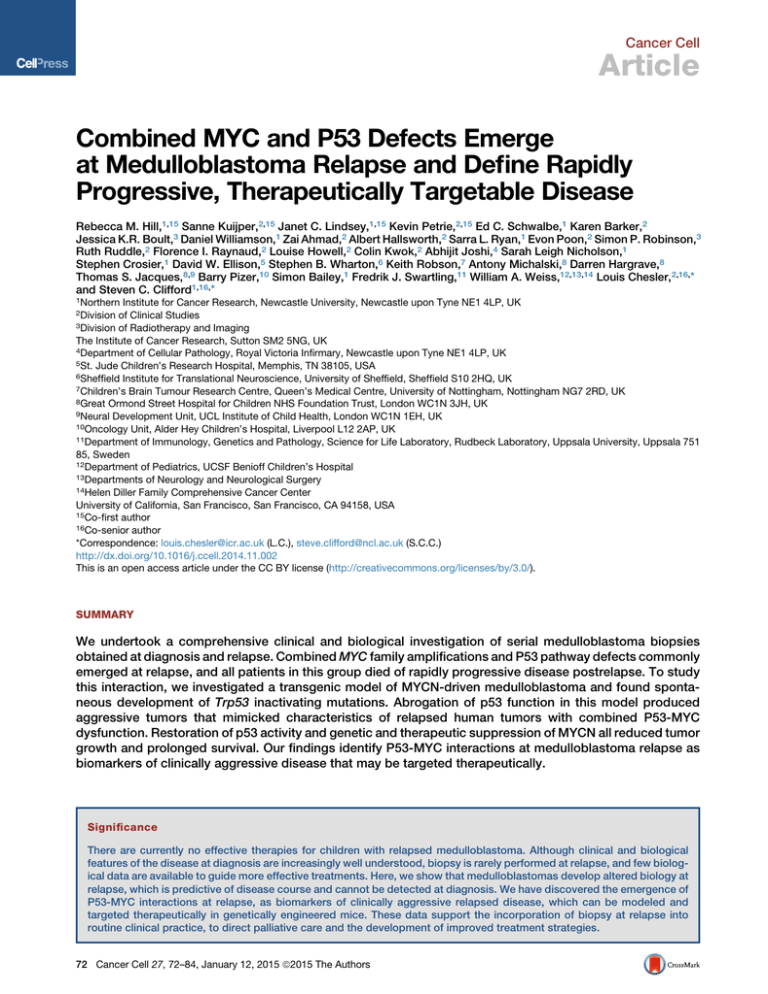
Cancer Cell
Article
Combined MYC and P53 Defects Emerge
at Medulloblastoma Relapse and Define Rapidly
Progressive, Therapeutically Targetable Disease
Rebecca M. Hill,1,15 Sanne Kuijper,2,15 Janet C. Lindsey,1,15 Kevin Petrie,2,15 Ed C. Schwalbe,1 Karen Barker,2
Jessica K.R. Boult,3 Daniel Williamson,1 Zai Ahmad,2 Albert Hallsworth,2 Sarra L. Ryan,1 Evon Poon,2 Simon P. Robinson,3
Ruth Ruddle,2 Florence I. Raynaud,2 Louise Howell,2 Colin Kwok,2 Abhijit Joshi,4 Sarah Leigh Nicholson,1
Stephen Crosier,1 David W. Ellison,5 Stephen B. Wharton,6 Keith Robson,7 Antony Michalski,8 Darren Hargrave,8
Thomas S. Jacques,8,9 Barry Pizer,10 Simon Bailey,1 Fredrik J. Swartling,11 William A. Weiss,12,13,14 Louis Chesler,2,16,*
and Steven C. Clifford1,16,*
1Northern
Institute for Cancer Research, Newcastle University, Newcastle upon Tyne NE1 4LP, UK
of Clinical Studies
3Division of Radiotherapy and Imaging
The Institute of Cancer Research, Sutton SM2 5NG, UK
4Department of Cellular Pathology, Royal Victoria Infirmary, Newcastle upon Tyne NE1 4LP, UK
5St. Jude Children’s Research Hospital, Memphis, TN 38105, USA
6Sheffield Institute for Translational Neuroscience, University of Sheffield, Sheffield S10 2HQ, UK
7Children’s Brain Tumour Research Centre, Queen’s Medical Centre, University of Nottingham, Nottingham NG7 2RD, UK
8Great Ormond Street Hospital for Children NHS Foundation Trust, London WC1N 3JH, UK
9Neural Development Unit, UCL Institute of Child Health, London WC1N 1EH, UK
10Oncology Unit, Alder Hey Children’s Hospital, Liverpool L12 2AP, UK
11Department of Immunology, Genetics and Pathology, Science for Life Laboratory, Rudbeck Laboratory, Uppsala University, Uppsala 751
85, Sweden
12Department of Pediatrics, UCSF Benioff Children’s Hospital
13Departments of Neurology and Neurological Surgery
14Helen Diller Family Comprehensive Cancer Center
University of California, San Francisco, San Francisco, CA 94158, USA
15Co-first author
16Co-senior author
*Correspondence: louis.chesler@icr.ac.uk (L.C.), steve.clifford@ncl.ac.uk (S.C.C.)
http://dx.doi.org/10.1016/j.ccell.2014.11.002
This is an open access article under the CC BY license (http://creativecommons.org/licenses/by/3.0/).
2Division
SUMMARY
We undertook a comprehensive clinical and biological investigation of serial medulloblastoma biopsies
obtained at diagnosis and relapse. Combined MYC family amplifications and P53 pathway defects commonly
emerged at relapse, and all patients in this group died of rapidly progressive disease postrelapse. To study
this interaction, we investigated a transgenic model of MYCN-driven medulloblastoma and found spontaneous development of Trp53 inactivating mutations. Abrogation of p53 function in this model produced
aggressive tumors that mimicked characteristics of relapsed human tumors with combined P53-MYC
dysfunction. Restoration of p53 activity and genetic and therapeutic suppression of MYCN all reduced tumor
growth and prolonged survival. Our findings identify P53-MYC interactions at medulloblastoma relapse as
biomarkers of clinically aggressive disease that may be targeted therapeutically.
Significance
There are currently no effective therapies for children with relapsed medulloblastoma. Although clinical and biological
features of the disease at diagnosis are increasingly well understood, biopsy is rarely performed at relapse, and few biological data are available to guide more effective treatments. Here, we show that medulloblastomas develop altered biology at
relapse, which is predictive of disease course and cannot be detected at diagnosis. We have discovered the emergence of
P53-MYC interactions at relapse, as biomarkers of clinically aggressive relapsed disease, which can be modeled and
targeted therapeutically in genetically engineered mice. These data support the incorporation of biopsy at relapse into
routine clinical practice, to direct palliative care and the development of improved treatment strategies.
72 Cancer Cell 27, 72–84, January 12, 2015 ª2015 The Authors
Cancer Cell
MYC-P53 Interactions at Medulloblastoma Relapse
INTRODUCTION
Relapse following conventional treatment is the single most
adverse event in medulloblastoma; over 95% of relapsing patients die, accounting for 10% of childhood cancer deaths
(Pizer and Clifford, 2009). Biological investigations have to date
focused on the disease at diagnosis, where disease-wide 5
year survival rates currently stand at 60%–70% (Pizer and Clifford, 2009). These studies have shown medulloblastoma is biologically heterogeneous, comprising four molecular subgroups
(WNT [MBWNT], SHH [MBSHH], group 3 [MBGroup3], and group 4
[MBGroup4]) with distinct clinical, pathological, and molecular features (Kool et al., 2012; Taylor et al., 2012). Moreover, disease
features have been identified at diagnosis that are consistently
associated with clinical outcomes. For high-risk disease, these
are MYC gene family (MYC, MYCN) amplification, TP53 mutation, chromosome 17 defects, large-cell anaplastic pathology,
metastatic disease, and subtotal surgical resection, whereas favorable-risk disease is defined by the MBWNT subgroup and
desmoplastic/nodular pathology in infants (Ellison et al., 2005,
2011; McManamy et al., 2007; Northcott et al., 2012a; Pfister
et al., 2009; Pizer and Clifford, 2009; Rutkowski et al., 2009;
Ryan et al., 2012; Taylor et al., 2012; Zhukova et al., 2013).
Together, these recent advances in understanding of the disease
at diagnosis are rapidly informing the design of biologically
driven phase III clinical trials aimed at improved outcomes
through enhanced disease-risk stratification (Pizer and Clifford,
2009).
Patient management at relapse, however, typically focuses on
quality of remaining life rather than curative strategies. This
absence of suitable treatment alternatives has stemmed primarily from a lack of clinical and biological data, because biopsy is
rarely performed at this stage. Consequently, this has impeded
the characterization of mechanisms that drive medulloblastoma
relapse, and the relevance of all the established medulloblastoma disease features in the relapsed setting, has not been
investigated. Moreover, this has prevented functional validation
of molecular targets using animal disease models, and their
assessment as biomarkers of disease course, to support the
development of more effective treatments.
We therefore assembled a clinical-trials-based cohort of patient-derived medulloblastoma biopsies sampled at relapse
and aimed to undertake a comprehensive analysis of their clinical and biological characteristics, in contrast with their diagnostic counterparts. Coupled with the subsequent functional
validation of specific biological features which commonly
emerge at relapse (combined P53-MYC defects), using genetically engineered mouse models, we further aimed to assess their
potential as biomarkers of clinically aggressive relapsed disease,
and as therapeutic targets, for the improved management of patients with relapsed medulloblastoma.
RESULTS
Disease Characteristics of Relapsed Medulloblastoma
We undertook a detailed assessment of the clinical, pathological, and molecular characteristics of relapsed medulloblastoma,
in a cohort of 29 recurrent tumors and their paired diagnostic
samples, recruited from the recent UK Children’s Cancer and
Leukemia Group (CCLG) Recurrent PNET (CNS 2000 01) trial
(Pizer et al., 2011) and UK CCLG treatment centers. We first assessed all molecular disease features with established significance at diagnosis including chromosome 17 and P53 pathway
status (TP53 mutation and p53 nuclear accumulation, CDKN2A
[p14ARF] and MDM2 status), MYC gene family (MYC, MYCN)
amplification, polyploidy, CTNNB1 mutation, and molecular subgroup status (Table 1; Table S1 available online) (Ellison et al.,
2011, 2005; Frank et al., 2004; Jones et al., 2012; Northcott
et al., 2012a, 2012b; Pfister et al., 2009; Robinson et al., 2012;
Ryan et al., 2012; Taylor et al., 2012; Zhukova et al., 2013).
Only the tumor molecular subgroup was unchanged at diagnosis
and relapse in all cases (Figure 1A), in agreement with the only
other published cohort of medulloblastomas sampled and subgrouped at relapse (Ramaswamy et al., 2013). Subgroup distribution in the cohort of relapsed tumors sampled in our study
was also consistent with Ramaswamy et al., as well as an unbiased cohort of relapsing tumors from a trial-based medulloblastoma study that were sampled at diagnosis (Schwalbe et al.,
2013) (Table S2).
All other features examined showed evidence of alteration at
relapse, with the majority (30/44, 68%) representing acquired
high-risk disease features (Figures 1B and 1C; Table 1; Table
S3) (Lannering et al., 2012; McManamy et al., 2007). Distant
metastases were significantly enriched at both diagnosis and
recurrence in our relapsed study cohort compared to large historic cohorts of tumors taken at diagnosis (p < 0.003), whereas
high-risk molecular features (MYC and MYCN gene amplification, TP53 mutation) occurred at significantly greater frequencies
at relapse than at diagnosis (Figures 1B and 1C; Figures S1A–
S1E; Table S3) (Pfaff et al., 2010; Pfister et al., 2009; Ryan
et al., 2012). Aggressive pathology (large-cell anaplastic [LCA]
variant) and TP53 mutation were always either maintained from
diagnosis to relapse or acquired at relapse. Two of two assessable TP53 mutations tumors were somatic in origin. TP53 mutation was identified in three of six p53-immunopositive tumors
sampled at diagnosis (versus 0/17 immunonegative; p = 0.04,
Fisher’s exact test) and eight of nine immunopositive tumors
sampled at relapse (versus 0/18 immunonegative; p = 4 3
10 6, Fisher’s exact test, Table 1). Relapse following upfront
radiotherapy (RT) was fatal in all cases (22/22). The only longterm survivors were infants receiving RT at recurrence (four of
four, median overall survival 17 years (range 8.9–19.2 years); Figures S1F–S1H; Table 1).
Combined MYC and P53 Defects Commonly Emerge
at Medulloblastoma Relapse
P53 pathway defects (TP53 mutation, CDKN2A deletion) and
MYC gene family amplification were the only disease features,
which were significantly associated at relapse (Figure S2A). In
patients receiving standard upfront radiotherapy and chemotherapy, these defects emerged in combination and were significantly more frequent at relapse (32% [seven of 22]) compared to
diagnosis (0/19; p = 0.01, Fisher’s exact test, Figures 2A and 2B).
Single MYC gene family (n = 1) or P53 pathway aberrations (n = 1)
were rarely observed in isolation at relapse in this treatment
group (Figure 2A).
Combined P53-MYC defects characterized relapsed tumors of
all molecular subgroups and occurred in combinations of specific
Cancer Cell 27, 72–84, January 12, 2015 ª2015 The Authors 73
74 Cancer Cell 27, 72–84, January 12, 2015 ª2015 The Authors
Table 1. Detailed Clinical, Pathological, and Molecular Characteristics of 29 Paired Medulloblastomas Sampled at Diagnosis and Relapse Showing Altered and Acquired
Features at Relapse
Cancer Cell
MYC-P53 Interactions at Medulloblastoma Relapse
Demographic frequencies and altered and acquired events are shown as a proportion and percentage of the data available for each variable. D, diagnosis; R, relapse. Consensus molecular subgroup: red, SHH/MBSHH; blue, WNT/MBWNT; yellow, G3/MBGroup3; green, G4/MBGroup4. Pathology variant: CLA, classic; LCA, large-cell/anaplastic; DN, desmoplastic/nodular; NOS, medulloblastoma not otherwise specified. Disease location: local, M0/M1; distant, M2+. Biopsy site: gray square, primary tumor biopsied; white square, metastatic site biopsied; U, biopsy site unknown; crossed
square, biopsy sample not available. Current status: ADF, alive disease-free; DOD, died of disease; DOTC, died of treatment complications. Chromosome 17 status: red, loss; green, gain. Other
categories: gray square, feature present; white square, feature absent; crossed square, data not available. See also Table S1 and S2.
Cancer Cell
MYC-P53 Interactions at Medulloblastoma Relapse
defects that are not observed at diagnosis. Only combined TP53
mutation/MYCN amplification in MBSHH have previously been
observed at diagnosis (6% of MBSHH) (Zhukova et al., 2013).
Direct comparison with the incidence of P53-MYC defects in
our own large cohort (n = 344) of uniformly characterized primary
medulloblastomas, sampled and subgrouped at diagnosis,
showed significant enrichment of these combined defects in
relapsed MBSHH subgroup tumors following treatment with standard chemotherapy and radiotherapy (60% [three of five] versus
12% [eight of 65] at diagnosis [p = 0.0250, Figure 2B]). Equivalent
trends were observed for the instances of combined P53-MYC
alterations detected in relapsed MBWNT and MBGroup3 tumors
(one of two tumors in both groups); these defects were not
observed in any tumor sampled at diagnosis (0/48 [p = 0.0400]
and 0/124 [p = 0.0159], respectively, Figure 2B). Combined defects observed at relapse in MBGroup4 following conventional
therapy were apparently less frequent than in MBSHH (one of
nine versus three of five; p = 0.095, Fisher’s exact test). Moreover,
combinations of specific P53-MYC defects were uniquely
observed at relapse and were not observed at diagnosis in our
large control cohorts, or in previously reported studies (Pfaff
et al., 2010) (e.g., CDKN2A deletion and MYC amplification in a
relapsed MBGroup3 tumor; TP53 mutation and MYC amplification
in a relapsed MBSHH tumor; TP53 mutation and MYCN amplification in a relapsed MBGroup4 tumor; TP53 mutation and MYC
amplification in a relapsed MBWNT tumor).
P53 pathway and MYC gene family defects combined at
relapse, both through maintenance of defects from diagnosis
(P53 pathway) and/or the emergence at relapse (P53 pathway,
MYC gene family) of one or both events (Figure 2C). Assessments of intratumoral molecular heterogeneity by single-cell
iFISH and deep sequencing supported both de novo acquisition
and clonal enrichment as mechanisms of defect emergence at
relapse and demonstrated the occurrence of both defects in
the same cell (Figure S2B).
P53-MYC Interactions Characterize Locally Aggressive
Relapsed Disease
Importantly, the co-occurrence of P53 pathway and MYC gene
family defects at relapse defined a population of patients with
clinically aggressive tumors in which time to relapse was equivalent to that of other patients, but time to death (TTD) was significantly more rapid postrecurrence (Figure 2D; Table S4). These
combined P53-MYC defects were the most significant independent predictor of TTD in multivariate survival analysis, which
included tumor molecular subgroup. This group of patients all
died quickly within 9 months following relapse (0.57 years
[0.33–0.72 years range] median time to death post-relapse,
versus 1.22 years for other tumors [0.02–2.9 years]; p =
0.0165). Moreover, MYC-P53 and MYCN-P53 defects remained
significantly associated with TTD when considered in isolation
against patients without combined defects (p = 0.0183 and
0.0039, respectively, log rank test).
Relapsed tumors with P53-MYC defects were significantly
associated with adverse LCA pathology (Ellison et al., 2011;
McManamy et al., 2007) (four of five assessable tumors, 80%,
p = 0.0099, Fisher’s exact test), but most did not have distant
metastases (five of seven, 71%), suggesting locally aggressive
disease (Figure 2E). Moreover, these tumors could not be distin-
guished by their clinical and pathological features and require biopsy and staging at the molecular level. In summary, our findings
demonstrate that the emergence of combined MYC gene family
amplification and P53 pathway defects is a common event at
relapse following standard upfront therapy, associated with an
aggressive clinical course, and can occur in tumors from all molecular disease subgroups and in specific combinations of genetic events that are not observed at diagnosis. Such patients
could potentially be targeted using biomarker-driven, individualized therapeutic approaches.
Trp53 and MYCN Interact Directly in Medulloblastoma
Development
These clinical observations and previous modeling of medulloblastoma in mice suggested that aberrant activation of the
MYC gene family synergizes with inactivation of p53 or Rb in
the genesis of biologically aggressive medulloblastoma (Kawauchi et al., 2012; Pei et al., 2012; Shakhova et al., 2006). The hypothesis that MYC or MYCN specifically interacts with p53 loss
of function was established in recent studies in which Trp53-inactivated murine cerebellar stem or progenitor cells were transformed by forced overexpression of exogenous Myc or Mycn,
driving formation of aggressive tumors resembling human medulloblastoma following transplantation into the cerebellum (Kawauchi et al., 2012; Pei et al., 2012). To investigate whether the P53MYC interaction could be directly responsible for the genesis of
spontaneous tumors within a native anatomic and developmental
context, we examined Trp53 status using a transgenic MYCNdriven mouse model (GTML; Glt1-tTA/TRE-MYCN-Luc) (Swartling et al., 2010). Selection of this experimental system was of
particular interest given that GTML is a native transgenic model
of medulloblastoma driven by fully reversible expression of
MYCN, allowing direct assessment of its role in spontaneous
tumor development. Somatic Trp53 DNA-binding domain mutations were found in 83% of tumors examined (ten of 12) (Figure S3A; Table S5). We next tested directly whether tumor growth
was dependent on both p53 and MYCN by generating GTML
mice deficient in functional p53, using a mouse model in which
the endogenous Trp53 gene is replaced with a knockin allele
(Trp53KI) encoding a 4-hydroxytamoxifen (4-OHT)-regulatable
p53ERTAM fusion protein (Christophorou et al., 2005). Mice
completely deficient for p53 (GTML/Trp53KI/KI) developed tumors with dramatically increased penetrance and significantly
decreased overall survival (100%, 43/43 versus 6%, three of
50 in GTML, p < 0.0001, Figure 3A). Medulloblastomas from
GTML/Trp53KI/WT and GTML/Trp53KI/KI mice uniformly displayed
aggressive clinical and pathological features (high mitotic index,
LCA pathology) equivalent to that of tumors in GTML mice with
spontaneous Trp53 mutations (Figure 3B). Moreover, tumors of
all three genotypes were representative of the locally aggressive
disease features (i.e., nonmetastatic, LCA) of the majority of P53MYC-associated relapsed human tumors (Figures 2E, 3B, and
S3B) and displayed gene expression profiles characteristic of human MBGroup3 (Figures 3C and S3C).
MYCN-Driven Murine Tumor Maintenance Is Dependent
on p53 and MYCN Status
Both p53 loss of function and expression of MYCN were
required for maintenance of GTML/Trp53KI/KI tumors. Addition
Cancer Cell 27, 72–84, January 12, 2015 ª2015 The Authors 75
Cancer Cell
MYC-P53 Interactions at Medulloblastoma Relapse
Figure 1. Relapsed Medulloblastomas Maintain the Molecular Subgroup but Are Enriched for Multiple High-Risk Clinical and Molecular
Features
(A) Consensus clustering (left) and principal component analysis (PCA) (right) of medulloblastoma subgroups at diagnosis and relapse. Consensus molecular
subgroups: red, MBSHH; blue, MBWNT; yellow, MBGroup3; green, MBGroup4. In the PCA plot, subgroups assigned at diagnosis are represented by circles, and those
assigned at relapse are represented by squares.
(B) Frequency of high-risk disease features within the present paired relapse study cohort sampled at diagnosis and relapse, compared to large historic cohorts
sampled at disease diagnosis. p, Fisher’s exact test.
(legend continued on next page)
76 Cancer Cell 27, 72–84, January 12, 2015 ª2015 The Authors
Cancer Cell
MYC-P53 Interactions at Medulloblastoma Relapse
of either tamoxifen (Tam), which is metabolized to 4-OHT in
the liver leading to reactivation of p53, or Dox (suppression of
MYCN expression) resulted in loss of clonogenic capacity and
reduced growth in GTML/Trp53KI/KI medulloblastoma-derived
neurospheres, associated with loss of MYCN expression and induction of p53 target genes, respectively (Figures S3D–S3F).
In vivo, administration of either drug led to increased survival
in GTML/Trp53KI/KI mice, relating to inhibition of tumor growth
(Tam) or induction of tumor regression (Dox) (Figures 3D and
3E). Treatment with either Dox or Tam led to dramatic tumorspecific reductions in the Ki-67 cellular proliferation marker,
Dox-specific loss of MYCN expression, or Tam-specific induction of the p53 target Cdkn1a (Figures 3F–3H; Figure S3G).
Together, these findings validate the critical dependency
of MYCN-driven murine tumor growth on TP53 defects. The
continued dependency on this interaction for tumor maintenance offers the potential for therapeutic intervention in
relapsed human medulloblastomas.
Therapeutic Targeting with Aurora-A Kinase Inhibitors
We recently showed that small molecules that target the kinase
domain of Aurora-A, a MYCN-binding protein and gatekeeper of
MYCN oncoprotein stability, can induce regression and differentiation of MYCN-driven neuroblastoma (Brockmann et al., 2013),
highlighting the clinical feasibility of targeting MYCN using this
class of inhibitor. In vitro treatment of GTML/Trp53KI/KI medulloblastoma-derived neurospheres with the Aurora-A kinase inhibitor MLN8237 (Alisertib) destabilized MYCN via disruption of the
Aurora-A/MYCN complex and caused growth inhibition comparable to doxycycline-mediated genetic suppression of MYCN
expression (Figure 4A; Figures S4A–S4C). Consistent with their
relationship to human MBGroup3, GTML/Trp53KI/KI tumors lack
sonic hedgehog (SHH) signaling as evidenced by absence of
Gli1 expression (Figure S4D). Thus, treatment with the SHH
antagonist GDC-0449 (Vismodegib), which specifically targets
medulloblastoma of granule cell origin driven by SHH expression, had no effect on MYCN and failed to reduce clonogenic
capacity or growth of GTML/Trp53KI/KI-derived medulloblastoma neurospheres (Figures S4A, S4B, and S4E). Moreover,
MLN8237 but not GDC-0449 significantly prolonged survival in
medulloblastoma-bearing GTML/Trp53KI/KI mice (Figure 4B).
Treatment with MLN8237 completely inhibited tumor growth as
measured by MRI (Figure 4C). In vivo compound measurement
revealed both MLN8237 and GDC-0449 achieved blood-brain
barrier penetration (Figure S4F). MLN8237 treatment led to an
increase in phosphorylated histone H3 (indicative of an accumulation in G2 and mitosis due to Aurora-A inhibition) as well as specific reductions in both MYCN and Ki-67, but not an increase in
cleaved caspase-3 (Figures 4D and 4E). Together, these results
demonstrate the target-dependent activity of MLN8237 against
GTML/Trp53KI/KI medulloblastomas and suggest clinical benefit
in treating relapsed P53-MYC medulloblastoma with agents that
target aberrant expression of MYCN.
DISCUSSION
Patients with medulloblastoma who relapse following upfront
radiotherapy rarely survive, irrespective of therapy received
postrecurrence (Pizer et al., 2011). Importantly, here we show
that, whereas tumor subgroup did not change, clinical, pathological, and other molecular disease features were commonly
altered at relapse. The emergence of combined P53-MYC
gene family defects at relapse following standard upfront
therapy is a common feature that occurs across disease subgroups, involves specific combinations of events not observed
at diagnosis, and is associated with rapid progression to
death. The validation of these combined mutations as therapeutically targetable molecular drivers of tumorigenesis in
genetically engineered mice demonstrates the development
of effective therapies for relapsed medulloblastoma will require
strategies tailored to the unique molecular features of these
tumors.
This study shows GTML/Trp53KI/KI mice to be an important
model for understanding and targeting P53-MYC family interactions in medulloblastoma. Our preclinical investigations targeting
Aurora-A kinase inhibition with MLN8237 in GTML/Trp53KI/KI
mice, together with recent research describing CD532 (an
Aurora-A inhibitor structurally distinct from MLN8237) (Gustafson et al., 2014), demonstrate proof-of-principle for indirect
therapeutic targeting of MYCN in medulloblastoma and its
advancement to the clinic. Establishment of their wider relevance to medulloblastoma at diagnosis, alongside other MYC/
MYCN amplified and overexpressing malignancies, is paramount. Furthermore, the essential role of loss of functional p53
in GTML/Trp53KI/KI tumor growth suggests additional opportunities for intervention with emerging therapeutics that reactivate
wild-type P53 by inhibiting the P53-MDM2 interaction (Carol
et al., 2013; Chène, 2003; Van Maerken et al., 2014).
Our continuously collected and centrally reviewed trials-based
cohort of 29 relapsed medulloblastomas is both representative
of other reported relapse cohorts and reflective of the expected
subgroup distribution of tumors at relapse (Table S2). Its investigation has enabled a comprehensive characterization of the
clinical, pathological, and biological features of relapsed medulloblastoma and important discoveries with immediate implications for future clinical and research strategies. Although
subgroup stability at relapse supports the use of diagnostic biopsy to define subgroup-directed therapies at relapse (e.g.,
SHH pathway inhibitors) (Rudin et al., 2009), we now understand
that medulloblastomas display unique and emergent biology at
relapse, which cannot be predicted at diagnosis. The identification of critical biomarkers such as P53-MYC defects in relapsed
tumors will allow us, in the short term, to adapt palliative strategies tailoring therapy to predicted disease course and quality of
remaining life. Looking to the future, the discovery of additional
clinically relevant biomarkers will inform the further development
and stratified use of targeted therapies. We particularly note
(C) Acquisition of molecular and clinical disease features between diagnosis (top) and relapse (bottom). Left to right: immunohistochemical analysis of p53 protein
accumulation; TP53 homozygous missense mutation (Pro152Leu); interphase fluorescence in situ hybridization (iFISH) showing MYCN amplification (green
versus centromeric control (red); H&E showing LCA acquisition and magnetic resonance imaging (MRI) showing metastatic spread (arrows indicate tumor site).
Scale bars, 50 mM (immunohistochemistry, H&E) or 5 mM (iFISH).
See also Figure S1 and Table S3.
Cancer Cell 27, 72–84, January 12, 2015 ª2015 The Authors 77
Cancer Cell
MYC-P53 Interactions at Medulloblastoma Relapse
Figure 2. Combined P53 Pathway Defects and MYC/MYCN Amplification Commonly Emerge following Standard Upfront Radiotherapy and
Chemotherapy and Correlate with Rapid Disease Progression after Relapse
(A–C) Association (A), frequency of occurrence and distribution within molecular subgroups (B), and patterns of emergence (C), of combined P53 pathway defects
and MYC/MYCN amplification at diagnosis and relapse.
(legend continued on next page)
78 Cancer Cell 27, 72–84, January 12, 2015 ª2015 The Authors
Cancer Cell
MYC-P53 Interactions at Medulloblastoma Relapse
MBGroup3 tumors are less commonly sampled at medulloblastoma relapse (this study; Ramaswamy et al., 2013), likely reflecting their associated early, disseminated pattern of relapse
(Ramaswamy et al., 2013) and a clinical decision not to biopsy.
The routine sampling of relapsed medulloblastoma is therefore
now essential to expand our findings, inform comprehensive biological investigations across all clinical and molecular disease
demographics, and direct clinical management and future therapeutic advances aimed at improved outcomes for children
with relapsed medulloblastoma.
EXPERIMENTAL PROCEDURES
Tumor Material and Clinical Data
Clinical data and tumor tissue were obtained for 29 patients from UK CCLG
institutions and collaborating centers (Table 1), encompassing patients
enrolled on the Recurrent PNET (CNS 2000 01) trial (Pizer et al., 2011). The
median age at diagnosis was 8.6 years (range 0.1–33.7 years), and median
age of recurrence was 10.7 years (range 2.4–36.3 years) with a median time
to relapse of 2.6 years (range 0.5–7.1 years). Within the cohort, six of 29
(21%) children at diagnosis were infants (<4 years old). Metastatic stage
was determined according to Chang’s criteria and pathology was centrally reviewed by a panel of neuropathologists from UK Children’s Cancer and Leukemia Group (CCLG) according to current WHO criteria (Chang et al., 1969;
Louis et al., 2007). Clinical data were collated and centrally reviewed.
Genomic DNA was extracted using standard methods, and validation of
paired sample identity was performed using a panel of microsatellite markers
(see below). Human tumor samples were provided by the UK CCLG as part
of CCLG-approved biological study BS-2007-04; informed consent was obtained from all subjects. Human tumor investigations were conducted with
approval from Newcastle/North Tyneside Research Ethics Committee (study
reference 07/Q0905/71).
Selection and Assessment of Critical Medulloblastoma Molecular
Features
Established medulloblastoma molecular features, with validated relationships
to disease molecular pathology and prognosis, were assessed. These
comprised (1) the four consensus medulloblastoma molecular subgroups
associated with distinct molecular events, clinicopathological features, and
prognosis (Taylor et al., 2012); (2) MYC and MYCN amplification (predominant
in MBGroup3 and MBSHH/Group4, respectively), and associated with poor
outcome (Ellison et al., 2011; Northcott et al., 2012a; Pfister et al., 2009; Pizer
and Clifford, 2009; Ryan et al., 2012); (3) TP53, one of the most frequently
mutated genes in medulloblastoma, associated with MBWNT/SHH, and reduced
survival rates in the MBSHH subgroup (Northcott et al., 2012a; Zhukova et al.,
2013); (4) additional defects of the P53 pathway (CDKN2A deletion/methylation, MDM2 amplification, and p53 nuclear accumulation) linked to poor
outcome in other pediatric embryonal tumors including relapsed neuroblastoma (Carr-Wilkinson et al., 2010; Frank et al., 2004); (5) CTNNB1 mutation,
associated with MBWNT (Taylor et al., 2012); (6) polyploidy, associated with
genomic instability, MBGroup3/MBGroup4 and poor prognosis (Jones et al.,
2012; Northcott et al., 2012a); and (7) defects of chromosome 17, including
the most common medulloblastoma cytogenetic abnormalities (i.e., gains of
17q, isochromosome 17q [i{17q}], and loss of 17p; Ellison et al., 2011; Pfister
et al., 2009; Taylor et al., 2012), associated with MBGroup3/MBGroup4 and poor
survival (Pfister et al., 2009; Shih et al., 2014).
Molecular Subgroup Status
All samples, where DNA was of sufficient quantity and quality as assessed by
PicoGreen dsDNA quantitation assay (Life Technologies), were processed on
the 450K methylation array (Illumina). Subgrouping according to methylation
status was achieved using established methods (Hovestadt et al., 2013;
Schwalbe et al., 2013). Consensus nonnegative matrix factorization (NMF)
clustering of a 225 member primary medulloblastoma training cohort was
used to define four methylation-dependent disease subgroups by identifying
subgroup-specific metagenes. A support vector machine (SVM) classifier to
assign subgroup for additional diagnostic and relapsed medulloblastoma
samples, based on their projected metagene profiles (Tamayo et al., 2007),
was developed using previously published methods (Schwalbe et al., 2013).
Confidence of the classifier call made for these samples was assessed by
repeated sampling of 80% of the training cohort to rederive the classifier.
Mutational analysis of CTNNB1 (Table S1) (Taylor et al., 2012) was performed
as previously described (Ellison et al., 2005, 2011) (see Supplemental Experimental Procedures).
Copy-Number Analysis in Clinical Samples
Copy-number estimates were carried out using iFISH, microsatellite typing, or
multiplex ligation-dependent probe amplification (MLPA) using SALSA reagents (MRC-Holland). Copy-number assessment by iFISH of MYC (8q24.21
probes), MYCN (2p24.3 probes), and chromosome 17 imbalances (17p13.3
and 17q12 probes) versus respective centromeric reference loci was performed on available material as previously described (Lamont et al., 2004;
Langdon et al., 2006; Nicholson et al., 2000). One hundred nonoverlapping
nuclei were scored by two independent assessors, and amplification was
defined as previously reported (Ryan et al., 2012).
Copy-number assessment by MLPA of MYC, MYCN, and MDM2 were
measured relative to four independent reference loci (B2M, TBP, 7q31, and
14q22). Normal diploid control samples were used to define cutoffs for the
detection of elevated copy numbers (>95% confidence interval of the normal
distribution). Tumor samples showing reproducibly elevated copy numbers (in
multiple replicates and versus three or more reference loci) were deemed to
have copy-number elevation. Samples with evidence of raised copy number
by MLPA were validated by iFISH on available material against a panel of
normal copy-number tumor controls.
Copy-number analysis of CDKN2A (p14ARF) was performed using
polymorphic microsatellite markers for chromosome 9p21 (d9s942 and
d9s1748) as previously reported (Randerson-Moor et al., 2001). Copynumber status of three cases homozygous for both polymorphic microsatellite markers, suggestive of chromosomal deletion at the CDKN2A locus
(Berggren et al., 2003), was further assessed by 450K methylation array
(Sturm et al., 2012) (n = 2) or the Illumina Human Omniexpress array (Illumina
(n = 1). Methylation of CDKN2A was also assessed by 450K methylation
array.
Analysis of TP53 Status in Clinical Samples
Immunohistochemistry (IHC) in human samples for p53 immunopositivity, previously associated with TP53 mutation (Pfaff et al., 2010; Tabori et al., 2010),
was performed on formalin-fixed, paraffin-embedded (FFPE) samples
(M7001, Dako) using the Menapath Polymer HRP Detection system (A. Menarini Diagnostics). All samples were analyzed by a neuropathologist, blind to
mutation status, and by a nuclear stain algorithm (Spectrum, Aperio Technologies). TP53 mutation status was assessed by direct PCR-based DNA
sequence analysis, and one tumor pair was assessed by next-generation
sequencing (see Supplemental Experimental Procedures).
(D) Survival of patients with tumors harboring combined P53-MYC gene family defects versus other tumors, showing time from diagnosis to relapse (top) and
relapse to death (bottom). Circle, P53-MYC; square, P53-MYCN. p, log rank test, Bonferroni corrected.
(E) Detailed clinical, pathological, and molecular demographics of patients with combined P53-MYC gene family defects at relapse. D, diagnosis; R, relapse.
Consensus molecular subgroup (red, MBSHH; blue, MBWNT; yellow, MBGroup3; green, MBGroup4). Pathology variant: CLA, classic; LCA, large-cell/anaplastic; DN,
nodular/desmoplastic; NOS, medulloblastoma not otherwise specified. Disease location: local, M0/M1; distant, M2+. Biopsy site: gray square, primary tumor
biopsied; white square, metastatic site biopsied; crossed square, biopsy sample not available. Current status: DOD, died of disease. Chromosome 17 status: red,
loss; green, gain. Other categories: gray square, feature present; white square, feature absent; crossed square, data not available.
See also Figure S2 and Table S4.
Cancer Cell 27, 72–84, January 12, 2015 ª2015 The Authors 79
Cancer Cell
MYC-P53 Interactions at Medulloblastoma Relapse
(legend on next page)
80 Cancer Cell 27, 72–84, January 12, 2015 ª2015 The Authors
Cancer Cell
MYC-P53 Interactions at Medulloblastoma Relapse
Statistical Analysis of Clinical Samples
Chi-square and Fisher’s exact tests were used to assess associations between clinicopathological and molecular features, and p values were corrected
for multiple testing using the Bonferroni procedure (Abdi, 2007). The log rank
test was used to assess all univariate survival markers. Cox proportional hazards models were used to investigate the significance of variables for eventfree survival (EFS), overall survival (OS), and time to death (TTD) analyses in
(1) univariate and (2) multivariate models using forward likelihood-ratio testing.
In Vivo Studies
All experimental protocols were monitored and approved by The Institute of
Cancer Research Animal Welfare and Ethical Review Body, in compliance
with guidelines specified by the UK Home Office Animals (Scientific Procedures) Act 1986 and the United Kingdom National Cancer Research Institute
guidelines for the welfare of animals in cancer research (Workman et al.,
2010). GTML mice have been described previously (Swartling et al., 2010).
The Trp53KI/KI mice were kindly provided by G.I. Evan (Christophorou et al.,
2005) and crossed with GTML animals into a background of the FVB/NJ inbred
strain (Taketo et al., 1991). To image for bioluminescence expression, animals
were injected with 75 mg/kg D-luciferin in saline (PerkinElmer) prior to imaging
in the IVIS Lumina (PerkinElmer) using Living Image Software. Transgenic
GTML/Trp53KI/KI animals with bioluminescence signals higher than 1.5 3
10 9 photons/seconds (20–30 days of life) were randomized to treatment
groups and treated with 30 mg/kg MLN8237 (Alisertib, Millennium) or
50 mg/kg GDC-0449 (Vismodegib, LC Laboratories). MLN8237, GDC-0449,
and the respective vehicles were dosed orally on a daily basis. Doxycycline
was given via chow at 1,250 mg/kg diet to provide a daily dose of approximately 160 mg/kg. Restoration of wild-type p53 was achieved by administration of either 1 mg of tamoxifen dissolved in 100 ml peanut oil carrier daily by
intraperitoneal injection or via chow at 400 mg/kg diet to provide a daily
dose of approximately 64 mg/kg. Animals were monitored twice a week for
bioluminescence signal and were sacrificed upon detection of a signal higher
than 9 3 10 9 photons/second or overt signs of intracranial expansion associated with tumor growth. Mice were allowed access to food and water ad
libitum.
In Vivo Imaging
Multislice 1H MRI was performed on a 7T horizontal bore microimaging system
(Bruker Instruments) using a 3 cm birdcage coil and a 2.5 3 2.5 cm field of
view. Anesthesia was induced with a 10 ml/kg intraperitoneal injection of fentanyl citrate (0.315 mg/ml) plus fluanisone (10 mg/ml, Hypnorm, Janssen Pharmaceutical), midazolam (5 mg/ml, Hypnovel, Roche), and sterile water (1:1:2).
Core body temperature was maintained by warm air blown through the magnet
bore. Magnetic-field homogeneity was optimized by shimming over the entire
brain using an automated shimming routine (FASTmap). T2-weighted images
acquired using a rapid acquisition with refocused echoes (RARE) sequence
(12 contiguous 1 mm sagittal slices or 20 contiguous 1 mm axial slices,
256 3 256 matrix, four averages, echo times [TE] = 36 and 132 ms, repetition
time [TR] = 4.5 s, RARE factor = 8) were used for localization of the tumor and
measurement of tumor volume.
Neurosphere Isolation and Culture
Tissue isolated from GTML/Trp53KI/KI tumors was transferred into cold HBSS,
cut into 2–3 mm2 pieces and dissociated before trituration in medium and filtration through 70 mm mesh. To generate neurospheres, cells were cultured under
self-renewal conditions in DMEM/F12 medium (Life Technologies) supplemented with 2% B27 supplement (Life Technologies), 20 ng/ml epidermal
growth factor (Sigma-Aldrich), and 20 ng/ml fibroblast growth factor (Life Technologies). For in vitro analyses, cells were treated with the following drug
concentrations: 100 nM 4-OHT (Sigma-Aldrich), 1 mg/ml doxycycline (SigmaAldrich), 100 nM MLN8237, and 500 nM GDC-0449. Neurosphere formation
was assessed by performing limiting dilutions from 1,000 to 60 cells and imaging using a Celigo S Imaging Cell Cytometer (Brooks Life Science Systems).
Western Blot Analysis and IHC
Western blot analysis of mouse tissues and neurospheres was performed as previously described (Brockmann et al., 2013; Chesler et al., 2006). For IHC of
mouse tissues, samples were fixed in 4% paraformaldehyde in phosphate buffered saline for at least 24 hr, decalcified with 0.3 M EDTA, and processed using
a Leica ASP300S tissue processor. Sections were cut at 4 mM for hematoxylin
and eosin staining (H&E) staining and immunohistochemistry as previously
described (Chesler et al., 2006). Antibodies used were MYCN (OP-13, MerckMillipore), Ki-67 (556003, BD Biosciences), GFAP (Z0334, DAKO), Cleaved
Caspase 3 (9664, Cell Signaling Technology), Synaptophysin (180130, Life Technologies), Phospo-S10-Histone H3 (9706, Cell Signaling), phospho-AurkABC
(2914, Cell Signaling), AurkA (4718, Cell Signaling), Sonic Hedgehog (ab73958,
Abcam), Gli-1 (2534, Cell Signaling), and GAPDH (2118, Cell Signaling).
ACCESSION NUMBERS
The Gene Expression Omnibus (GEO) accession number for 450K DNA
methylation array profiles used for the determination of human medulloblastoma molecular subgroup status is GSE62618. The GEO accession number
for microarray expression profiles of mouse medulloblastomas is GSE62625.
The GEO SuperSeries accession number for this study is GSE62626.
SUPPLEMENTAL INFORMATION
Supplemental Information includes Supplemental Experimental Procedures,
four figures, and five tables and can be found with this article online at
http://dx.doi.org/10.1016/j.ccell.2014.11.002.
AUTHOR CONTRIBUTIONS
L.C. and S.C.C. conceived the study. S.L.N. and S.C. collected and processed
human tissue cohorts. D.H., B.P., D.W.E., and A.M. provided human tumor
Figure 3. Aberrant Expression of MYCN in Combination with p53 Loss of Function Drives Highly Penetrant and Aggressive Medulloblastoma
(A) Kaplan-Meier survival curves for GTML/Trp53KI/KI (n = 43), GTML/Trp53KI/WT (n = 83), or GTML transgenic mice (n = 50) mice as indicated. p, log rank test.
(B) H&E and immunohistochemical staining indicating levels of MYCN protein and cell proliferation (Ki-67) in GTML/Trp53KI/KI and GTML transgenic mice.
(C) Subgroup classification of mouse expression profiles using a support vector machine trained on human medulloblastoma expression profiles and nonnegative
matrix factorization for cross-species projection.
(D) Kaplan-Meier survival for GTML/Trp53KI/KI mice treated with doxycycline (Dox, n = 8) or tamoxifen (Tam, n = 10) compared to vehicle (n = 9) as indicated. p, log
rank test.
(E) GTML/Trp53KI/KI mice coexpressing firefly luciferase (FLuc) were treated with Tam, Dox, or vehicle for 9 days. Bioluminescent imaging of GTML/Trp53KI/KI
mice after 9 days treatment with Dox or Tam as indicated (top). Luminescence intensity at days 0 and 9 are shown (bottom). Data points represent individual mice.
p, unpaired t test.
(F) H&E and immunohistochemical staining indicating levels of MYCN, Ki-67, or apoptosis (cleaved caspase 3) in GTML/Trp53KI/KI mice after treatment with Dox
or Tam.
(G) RNAscope 2-plex chromogenic assay. Cdkn1a expression (red) was analyzed on brain sections from GTML/Trp53KI/KI mice treated with either Tam or vehicle
control as indicated. Samples were costained for expression of the Ubc (ubiquitin C) housekeeping gene (green). Expression of Ppib (Peptidylprolyl Isomerase B,
Cyclophilin B) (red) and Polr2a (DNA-directed RNA polymerase II subunit RPB1) (green) were used as positive controls. Expression of dapB (dihydrodipicolinate)
reductase gene from B. subtilis was used as a negative control. Sections were counterstained with Gill’s hematoxylin.
(H) Fold difference of human MYCN or mouse Cdkn1a mRNA levels in tumor tissues treated with either Dox or Tam. (p, unpaired t test.)
Scale bars, 50 mm. Error bars represent mean ± SD. See also Figure S3 and Table S5.
Cancer Cell 27, 72–84, January 12, 2015 ª2015 The Authors 81
Cancer Cell
MYC-P53 Interactions at Medulloblastoma Relapse
Figure 4. Therapeutic Targeting of the MYCN/Aurora-A Interaction Inhibits Tumor Growth and Prolongs Survival in GTML/Trp53KI/KI Mice
(A) Proximity ligation assay (PLA) analyzing MYCN/Aurora-A complexes in GTML/Trp53KI/KI neurospheres following MLN8237 treatment (48 hr). Left panel shows
close proximity (<40 nm) of antibody conjugated PLA probes that have been ligated, amplified, and detected with complementary fluorescent probes. Red dots
represent the presence of MYCN or Aurora-A protein, or MYCN/Aurora-A interactions as indicated. Antibodies used are indicated by white text (2 Ab, secondary
antibody control). Scale bar, 20 mm. Right panel shows mean values of signals (red dots) per cell representing MYCN expression or MYCN/Aurora-A interactions.
Values are derived from triplicate biological replicates, and error bars represent SDs. p, unpaired t test.
(legend continued on next page)
82 Cancer Cell 27, 72–84, January 12, 2015 ª2015 The Authors
Cancer Cell
MYC-P53 Interactions at Medulloblastoma Relapse
samples. S.B., S.C.C., and R.M.H. collected and centrally reviewed clinical
data. R.M.H., J.C.L., and S.C.C. designed experiments on human tumor cohorts, which were carried out by R.M.H., J.C.L., and S.L.R. E.C.S. planned
and executed human 450K methylation array analysis. R.M.H., J.C.L.,
E.C.S., and S.C.C. planned and carried out all other analyses of human tumor
data. T.S.J., K.R., and S.B.W. performed central pathology review of human
tumors. A.J. performed p53 immunohistochemistry analysis. S.K., K.P.,
F.J.S., W.A.W., and L.C. planned mouse experiments, which were carried
out by S.K. and A.H. MRI of tumors was planned by J.K.R.B. and S.P.R. and
carried out by J.K.R.B. In vivo compound measurement was planned by
R.R. and F.I.R. and carried out by R.R. S.K., K.P., and L.C. planned experiments to characterize tumor biology and response to therapeutics, which
were executed by S.K., K.B., Z.A., E.P., L.H., and C.K.; S.K., K.P., and L.C.
analyzed these data. D.W. planned and executed gene expression analysis
of mouse tumors. Histopathological analysis of mouse tumors was performed
by T.S.J. K.P., R.M.H., L.C., and S.C.C. wrote the manuscript.
ACKNOWLEDGMENTS
This study was supported by grants from Cancer Research UK (grants
C34648/A12054, C8464/A13457, and C1060/A10334), Action Medical
Research (RTF1414), Sparks (09NCL02), The Brain Tumour Charity (grants
SDR004X and 16/164), the JGW Patterson Foundation, and Christopher’s
Smile (CXC002H) and was undertaken as part of the INSTINCT network, cofunded by The Brain Tumour Charity, Great Ormond Street Children’s Charity,
and Children with Cancer UK (grant 16/193). T.S.J. is supported by the National Institute for Health Research and a Great Ormond Street Hospital UCL
Biomedical Research Centre award. F.I.R. and R.R. are employees of the Institute of Cancer Research and are involved in the development of aurora kinase
inhibitors.
Received: April 25, 2014
Revised: September 2, 2014
Accepted: November 5, 2014
Published: December 18, 2014
REFERENCES
Abdi, H. (2007). Bonferroni and Sidak corrections for multiple comparisons. In
Encyclopedia of Measurement and Statistics, N.J. Salkind, ed. (Thousand
Oaks, CA: Sage).
Berggren, P., Kumar, R., Sakano, S., Hemminki, L., Wada, T., Steineck, G.,
Adolfsson, J., Larsson, P., Norming, U., Wijkstrom, H., and Hemminki, K.
(2003). Detecting homozygous deletions in the CDKN2A(p16(INK4a))/
ARF(p14(ARF)) gene in urinary bladder cancer using real-time quantitative
PCR. Clin. Cancer Res. 9, 235–242.
Brockmann, M., Poon, E., Berry, T., Carstensen, A., Deubzer, H.E., Rycak, L.,
Jamin, Y., Thway, K., Robinson, S.P., Roels, F., et al. (2013). Small molecule
inhibitors of aurora-a induce proteasomal degradation of N-myc in childhood
neuroblastoma. Cancer Cell 24, 75–89.
Carol, H., Reynolds, C.P., Kang, M.H., Keir, S.T., Maris, J.M., Gorlick, R., Kolb,
E.A., Billups, C.A., Geier, B., Kurmasheva, R.T., et al. (2013). Initial testing of
the MDM2 inhibitor RG7112 by the Pediatric Preclinical Testing Program.
Pediatr. Blood Cancer 60, 633–641.
Carr-Wilkinson, J., O’Toole, K., Wood, K.M., Challen, C.C., Baker, A.G., Board,
J.R., Evans, L., Cole, M., Cheung, N.K., Boos, J., et al. (2010). High Frequency
of p53/MDM2/p14ARF Pathway Abnormalities in Relapsed Neuroblastoma.
Clin. Cancer Res. 16, 1108–1118.
Chang, C.H., Housepian, E.M., and Herbert, C., Jr. (1969). An operative staging system and a megavoltage radiotherapeutic technic for cerebellar medulloblastomas. Radiology 93, 1351–1359.
Chène, P. (2003). Inhibiting the p53-MDM2 interaction: an important target for
cancer therapy. Nat. Rev. Cancer 3, 102–109.
Chesler, L., Schlieve, C., Goldenberg, D.D., Kenney, A., Kim, G., McMillan, A.,
Matthay, K.K., Rowitch, D., and Weiss, W.A. (2006). Inhibition of phosphatidylinositol 3-kinase destabilizes Mycn protein and blocks malignant progression
in neuroblastoma. Cancer Res. 66, 8139–8146.
Christophorou, M.A., Martin-Zanca, D., Soucek, L., Lawlor, E.R., BrownSwigart, L., Verschuren, E.W., and Evan, G.I. (2005). Temporal dissection of
p53 function in vitro and in vivo. Nat. Genet. 37, 718–726.
Ellison, D.W., Onilude, O.E., Lindsey, J.C., Lusher, M.E., Weston, C.L., Taylor,
R.E., Pearson, A.D., and Clifford, S.C. (2005). beta-Catenin status predicts a
favorable outcome in childhood medulloblastoma: the United Kingdom
Children’s Cancer Study Group Brain Tumour Committee. J. Clin. Oncol. 23,
7951–7957.
Ellison, D.W., Kocak, M., Dalton, J., Megahed, H., Lusher, M.E., Ryan, S.L.,
Zhao, W., Nicholson, S.L., Taylor, R.E., Bailey, S., and Clifford, S.C. (2011).
Definition of disease-risk stratification groups in childhood medulloblastoma
using combined clinical, pathologic, and molecular variables. J. Clin. Oncol.
29, 1400–1407.
Frank, A.J., Hernan, R., Hollander, A., Lindsey, J.C., Lusher, M.E., Fuller, C.E.,
Clifford, S.C., and Gilbertson, R.J. (2004). The TP53-ARF tumor suppressor
pathway is frequently disrupted in large/cell anaplastic medulloblastoma.
Brain Res. Mol. Brain Res. 121, 137–140.
Gustafson, W.C., Meyerowitz, J.G., Nekritz, E.A., Chen, J., Benes, C., Charron,
E., Simonds, E.F., Seeger, R., Matthay, K.K., Hertz, N.T., et al. (2014). Drugging
MYCN through an allosteric transition in Aurora kinase A. Cancer Cell 26,
414–427.
Hovestadt, V., Remke, M., Kool, M., Pietsch, T., Northcott, P.A., Fischer, R.,
Cavalli, F.M., Ramaswamy, V., Zapatka, M., Reifenberger, G., et al. (2013).
Robust molecular subgrouping and copy-number profiling of medulloblastoma from small amounts of archival tumour material using high-density
DNA methylation arrays. Acta Neuropathol. 125, 913–916.
Jones, D.T., Jäger, N., Kool, M., Zichner, T., Hutter, B., Sultan, M., Cho, Y.J.,
Pugh, T.J., Hovestadt, V., Stütz, A.M., et al. (2012). Dissecting the genomic
complexity underlying medulloblastoma. Nature 488, 100–105.
Kawauchi, D., Robinson, G., Uziel, T., Gibson, P., Rehg, J., Gao, C.,
Finkelstein, D., Qu, C., Pounds, S., Ellison, D.W., et al. (2012). A mouse model
of the most aggressive subgroup of human medulloblastoma. Cancer Cell 21,
168–180.
Kool, M., Korshunov, A., Remke, M., Jones, D.T., Schlanstein, M., Northcott,
P.A., Cho, Y.J., Koster, J., Schouten-van Meeteren, A., van Vuurden, D.,
et al. (2012). Molecular subgroups of medulloblastoma: an international
meta-analysis of transcriptome, genetic aberrations, and clinical data of
WNT, SHH, Group 3, and Group 4 medulloblastomas. Acta Neuropathol.
123, 473–484.
Lamont, J.M., McManamy, C.S., Pearson, A.D., Clifford, S.C., and Ellison,
D.W. (2004). Combined histopathological and molecular cytogenetic stratification of medulloblastoma patients. Clin. Cancer Res. 10, 5482–5493.
(B) Kaplan-Meier survival for GTML/Trp53KI/KI mice treated with MLN8237 (n = 10), GDC-0449 SHH antagonist (n = 4), or vehicle (n = 11) as indicated. (p, log rank
test.)
(C) Longitudinal MRI analysis of tumor volume (n = 4) on the axial plane (top). Representative MRIs of the axial plane of MLN8237-treated animals compared to
vehicle as indicated at day 0 and last day of treatment (bottom).
(D) H&E and immunohistochemical staining indicating levels of MYCN protein, cell proliferation (Ki-67), apoptosis (cleaved caspase 3), or mitotic activity as
measured by phosphorylated Ser10 on histone H3 (H3 p-S10) after treatment with GDC-0449 or MLN8237. Scale bar, 50 mm.
(E) Immunoblotting of MYCN protein levels, and total and phosphorylated Thr288 on Aurora-A (p-T288 Aurora-A) in MLN8237-treated tumor tissues. For (D) and
(E), animals were treated with vehicle, GDC-0449, or MLN8237 for 48 hr, and samples were taken 2 hr after final administration of agent.
Error bars represent mean ± SD. See also Figure S4.
Cancer Cell 27, 72–84, January 12, 2015 ª2015 The Authors 83
Cancer Cell
MYC-P53 Interactions at Medulloblastoma Relapse
Langdon, J.A., Lamont, J.M., Scott, D.K., Dyer, S., Prebble, E., Bown, N.,
Grundy, R.G., Ellison, D.W., and Clifford, S.C. (2006). Combined genomewide allelotyping and copy number analysis identify frequent genetic losses
without copy number reduction in medulloblastoma. Genes Chromosomes
Cancer 45, 47–60.
Lannering, B., Rutkowski, S., Doz, F., Pizer, B., Gustafsson, G., Navajas, A.,
Massimino, M., Reddingius, R., Benesch, M., Carrie, C., et al. (2012).
Hyperfractionated versus conventional radiotherapy followed by chemotherapy in standard-risk medulloblastoma: results from the randomized multicenter HIT-SIOP PNET 4 trial. J. Clin. Oncol. 30, 3187–3193.
Louis, D.N., Ohgaki, H., Wiestler, O.D., Cavenee, W.K., Burger, P.C., Jouvet,
A., Scheithauer, B.W., and Kleihues, P. (2007). The 2007 WHO classification
of tumours of the central nervous system. Acta Neuropathol. 114, 97–109.
McManamy, C.S., Pears, J., Weston, C.L., Hanzely, Z., Ironside, J.W., Taylor,
R.E., Grundy, R.G., Clifford, S.C., and Ellison, D.W. (2007). Nodule formation
and desmoplasia in medulloblastomas-defining the nodular/desmoplastic
variant and its biological behavior. Brain Pathol. 17, 151–164.
Nicholson, J., Wickramasinghe, C., Ross, F., Crolla, J., and Ellison, D. (2000).
Imbalances of chromosome 17 in medulloblastomas determined by comparative genomic hybridisation and fluorescence in situ hybridisation. Mol.
Pathol. 53, 313–319.
Northcott, P.A., Jones, D.T., Kool, M., Robinson, G.W., Gilbertson, R.J., Cho,
Y.J., Pomeroy, S.L., Korshunov, A., Lichter, P., Taylor, M.D., and Pfister, S.M.
(2012a). Medulloblastomics: the end of the beginning. Nat. Rev. Cancer 12,
818–834.
Rudin, C.M., Hann, C.L., Laterra, J., Yauch, R.L., Callahan, C.A., Fu, L.,
Holcomb, T., Stinson, J., Gould, S.E., Coleman, B., et al. (2009). Treatment
of medulloblastoma with hedgehog pathway inhibitor GDC-0449. N. Engl. J.
Med. 361, 1173–1178.
Rutkowski, S., Gerber, N.U., von Hoff, K., Gnekow, A., Bode, U., Graf, N.,
Berthold, F., Henze, G., Wolff, J.E., Warmuth-Metz, M., et al. (2009).
Treatment of early childhood medulloblastoma by postoperative chemotherapy and deferred radiotherapy. Neuro-oncol. 11, 201–210.
Ryan, S.L., Schwalbe, E.C., Cole, M., Lu, Y., Lusher, M.E., Megahed, H.,
O’Toole, K., Nicholson, S.L., Bognar, L., Garami, M., et al. (2012). MYC family
amplification and clinical risk-factors interact to predict an extremely poor
prognosis in childhood medulloblastoma. Acta Neuropathol. 123, 501–513.
Schwalbe, E.C., Williamson, D., Lindsey, J.C., Hamilton, D., Ryan, S.L.,
Megahed, H., Garami, M., Hauser, P., Dembowska-Baginska, B., Perek, D.,
et al. (2013). DNA methylation profiling of medulloblastoma allows robust subclassification and improved outcome prediction using formalin-fixed biopsies.
Acta Neuropathol. 125, 359–371.
Shakhova, O., Leung, C., van Montfort, E., Berns, A., and Marino, S. (2006).
Lack of Rb and p53 delays cerebellar development and predisposes to large
cell anaplastic medulloblastoma through amplification of N-Myc and Ptch2.
Cancer Res. 66, 5190–5200.
Shih, D.J., Northcott, P.A., Remke, M., Korshunov, A., Ramaswamy, V., Kool,
M., Luu, B., Yao, Y., Wang, X., Dubuc, A.M., et al. (2014). Cytogenetic prognostication within medulloblastoma subgroups. J. Clin. Oncol. 32, 886–896.
Northcott, P.A., Shih, D.J., Peacock, J., Garzia, L., Morrissy, A.S., Zichner, T.,
Stütz, A.M., Korshunov, A., Reimand, J., Schumacher, S.E., et al. (2012b).
Subgroup-specific structural variation across 1,000 medulloblastoma genomes. Nature 488, 49–56.
Sturm, D., Witt, H., Hovestadt, V., Khuong-Quang, D.A., Jones, D.T.,
Konermann, C., Pfaff, E., Tönjes, M., Sill, M., Bender, S., et al. (2012).
Hotspot mutations in H3F3A and IDH1 define distinct epigenetic and biological
subgroups of glioblastoma. Cancer Cell 22, 425–437.
Pei, Y., Moore, C.E., Wang, J., Tewari, A.K., Eroshkin, A., Cho, Y.J., Witt, H.,
Korshunov, A., Read, T.A., Sun, J.L., et al. (2012). An animal model of MYCdriven medulloblastoma. Cancer Cell 21, 155–167.
Swartling, F.J., Grimmer, M.R., Hackett, C.S., Northcott, P.A., Fan, Q.W.,
Goldenberg, D.D., Lau, J., Masic, S., Nguyen, K., Yakovenko, S., et al.
(2010). Pleiotropic role for MYCN in medulloblastoma. Genes Dev. 24, 1059–
1072.
Pfaff, E., Remke, M., Sturm, D., Benner, A., Witt, H., Milde, T., von Bueren,
A.O., Wittmann, A., Schöttler, A., Jorch, N., et al. (2010). TP53 mutation is
frequently associated with CTNNB1 mutation or MYCN amplification and is
compatible with long-term survival in medulloblastoma. J. Clin. Oncol. 28,
5188–5196.
Pfister, S., Remke, M., Benner, A., Mendrzyk, F., Toedt, G., Felsberg, J.,
Wittmann, A., Devens, F., Gerber, N.U., Joos, S., et al. (2009). Outcome prediction in pediatric medulloblastoma based on DNA copy-number aberrations
of chromosomes 6q and 17q and the MYC and MYCN loci. J. Clin. Oncol. 27,
1627–1636.
Tabori, U., Baskin, B., Shago, M., Alon, N., Taylor, M.D., Ray, P.N., Bouffet, E.,
Malkin, D., and Hawkins, C. (2010). Universal poor survival in children with medulloblastoma harboring somatic TP53 mutations. J. Clin. Oncol. 28, 1345–
1350.
Taketo, M., Schroeder, A.C., Mobraaten, L.E., Gunning, K.B., Hanten, G., Fox,
R.R., Roderick, T.H., Stewart, C.L., Lilly, F., Hansen, C.T., et al. (1991). FVB/N:
an inbred mouse strain preferable for transgenic analyses. Proc. Natl. Acad.
Sci. USA 88, 2065–2069.
Pizer, B.L., and Clifford, S.C. (2009). The potential impact of tumour biology on
improved clinical practice for medulloblastoma: progress towards biologically
driven clinical trials. Br. J. Neurosurg. 23, 364–375.
Tamayo, P., Scanfeld, D., Ebert, B.L., Gillette, M.A., Roberts, C.W., and
Mesirov, J.P. (2007). Metagene projection for cross-platform, cross-species
characterization of global transcriptional states. Proc. Natl. Acad. Sci. USA
104, 5959–5964.
Pizer, B., Donachie, P.H., Robinson, K., Taylor, R.E., Michalski, A., Punt, J.,
Ellison, D.W., and Picton, S. (2011). Treatment of recurrent central nervous
system primitive neuroectodermal tumours in children and adolescents: results of a Children’s Cancer and Leukaemia Group study. Eur. J. Cancer 47,
1389–1397.
Taylor, M.D., Northcott, P.A., Korshunov, A., Remke, M., Cho, Y.J., Clifford,
S.C., Eberhart, C.G., Parsons, D.W., Rutkowski, S., Gajjar, A., et al. (2012).
Molecular subgroups of medulloblastoma: the current consensus. Acta
Neuropathol. 123, 465–472.
Ramaswamy, V., Remke, M., Bouffet, E., Faria, C.C., Perreault, S., Cho, Y.J.,
Shih, D.J., Luu, B., Dubuc, A.M., Northcott, P.A., et al. (2013). Recurrence patterns across medulloblastoma subgroups: an integrated clinical and molecular
analysis. Lancet Oncol. 14, 1200–1207.
Randerson-Moor, J.A., Harland, M., Williams, S., Cuthbert-Heavens, D.,
Sheridan, E., Aveyard, J., Sibley, K., Whitaker, L., Knowles, M., Bishop, J.N.,
and Bishop, D.T. (2001). A germline deletion of p14(ARF) but not CDKN2A in
a melanoma-neural system tumour syndrome family. Hum. Mol. Genet. 10,
55–62.
Robinson, G., Parker, M., Kranenburg, T.A., Lu, C., Chen, X., Ding, L., Phoenix,
T.N., Hedlund, E., Wei, L., Zhu, X., et al. (2012). Novel mutations target distinct
subgroups of medulloblastoma. Nature 488, 43–48.
84 Cancer Cell 27, 72–84, January 12, 2015 ª2015 The Authors
Van Maerken, T., Rihani, A., Van Goethem, A., De Paepe, A., Speleman, F., and
Vandesompele, J. (2014). Pharmacologic activation of wild-type p53 by nutlin
therapy in childhood cancer. Cancer Lett. 344, 157–165.
Workman, P., Aboagye, E.O., Balkwill, F., Balmain, A., Bruder, G., Chaplin,
D.J., Double, J.A., Everitt, J., Farningham, D.A.H., Glennie, M.J., et al.;
Committee of the National Cancer Research Institute (2010). Guidelines for
the welfare and use of animals in cancer research. Br. J. Cancer 102, 1555–
1577.
Zhukova, N., Ramaswamy, V., Remke, M., Pfaff, E., Shih, D.J., Martin, D.C.,
Castelo-Branco, P., Baskin, B., Ray, P.N., Bouffet, E., et al. (2013).
Subgroup-specific prognostic implications of TP53 mutation in medulloblastoma. J. Clin. Oncol. 31, 2927–2935.

